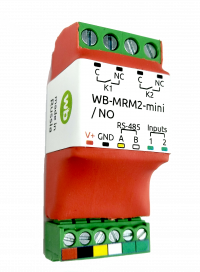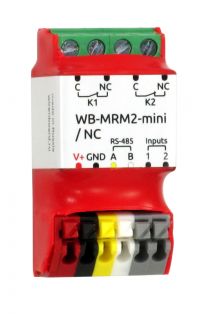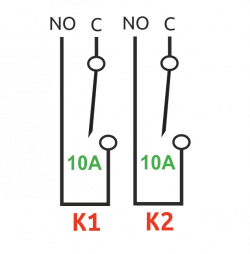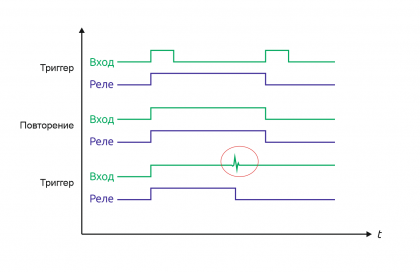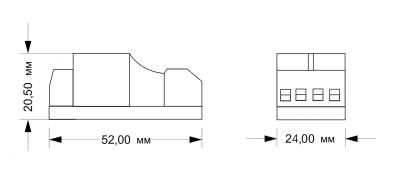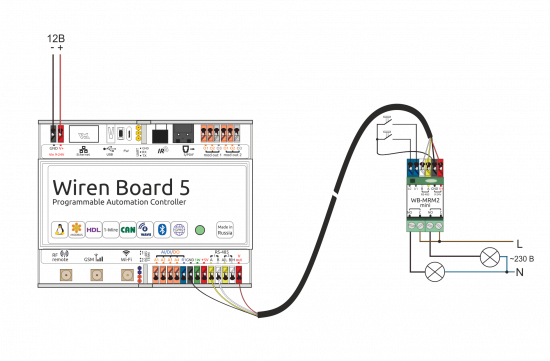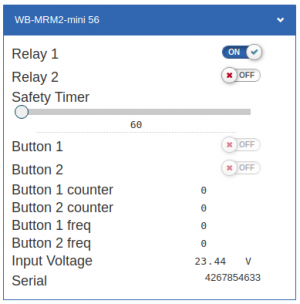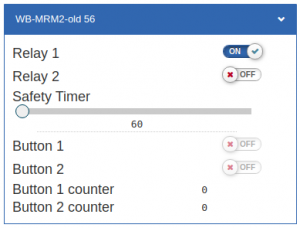WB-MRM2-mini Modbus Relay Modules/en: различия между версиями
(Новая страница: «{| border="1" class="wikitable" style="text-align:left" |- !Parameter !Value |- ! colspan="2" |"Power Supply" |- |Supply voltage |9 — 24 V DC |- |Power consumpt…») |
FuzzyBot (обсуждение | вклад) (Часть переводимой страницы WB-MRM2-mini.) |
||
| (не показано 35 промежуточных версий 2 участников) | |||
| Строка 2: | Строка 2: | ||
{{DISPLAYTITLE:Dual Channel Relay Mini-module WB-MRM2-mini}}{{#vardefine:ProductFullName1|Dual Channel Relay Mini-module WB-MRM2-mini NO}} {{#vardefine:FileName1|WB_MRM2-mini_NO}} {{#vardefine:ProductName1|WB_MRM2-mini_NO}} {{#vardefine:ProductFullName2|Dual Channel Relay Mini-module WB-MRM2-mini NC}} {{#vardefine:FileName2|WB_MRM2-mini_NC}} {{#vardefine:ProductName2|WB_MRM2-mini_NC}} | {{DISPLAYTITLE:Dual Channel Relay Mini-module WB-MRM2-mini}}{{#vardefine:ProductFullName1|Dual Channel Relay Mini-module WB-MRM2-mini NO}} {{#vardefine:FileName1|WB_MRM2-mini_NO}} {{#vardefine:ProductName1|WB_MRM2-mini_NO}} {{#vardefine:ProductFullName2|Dual Channel Relay Mini-module WB-MRM2-mini NC}} {{#vardefine:FileName2|WB_MRM2-mini_NC}} {{#vardefine:ProductName2|WB_MRM2-mini_NC}} | ||
'''[https://wirenboard.com/en/product/WB-MRM2-mini/ Buy online]''' | '''[https://wirenboard.com/en/product/WB-MRM2-mini/ Buy online]''' | ||
[[File: | [[File:MINI.png| thumb | 200px|Dual Channel Relay Mini-module WB-MRM2-mini v.2]] | ||
[[File: | [[File:MiniRelay-2.JPG| thumb | 200px|Dual Channel Relay Mini-module WB-MRM2-mini v.1]] | ||
== General information == | == General information == | ||
=== Purpose=== | === Purpose=== | ||
Two-channel relay module WB-MRM2-mini is designed for use in building automation systems. The module is | Two-channel relay module WB-MRM2-mini v.2 is designed for use in building automation systems. The WB-MRM2-mini v.1 featured all-in-one terminal blocks and a lower height (46 mm). The module is mnaged from the controller [[Wiren Board 6/en|Wiren Board 6]] or a computer via the bus [[RS-485/en| RS-485]] via [[Relay Module Modbus Management/en |Modbus Protocol]], as well as via external buttons connected to the module. Miniature dimensions of the module allow you to mount it next to the load in the cable channels, bowls lamps, deep installation boxes for sockets and switches. | ||
=== Outputs=== | === Outputs=== | ||
| Строка 23: | Строка 24: | ||
The screw-free terminals b1 and b2 of the module have 2 inputs of the dry contact type, not isolated from the power supply. RC chains are used on each input line to eliminate contact chatter. The inputs are pulled up by resistors to the +3.3 V power line. Buttons or switches with locking are connected between the GND pin and the corresponding b1 or b2 input. The inputs can be used as general-purpose inputs, for counting signals and for direct control of relay channels. | The screw-free terminals b1 and b2 of the module have 2 inputs of the dry contact type, not isolated from the power supply. RC chains are used on each input line to eliminate contact chatter. The inputs are pulled up by resistors to the +3.3 V power line. Buttons or switches with locking are connected between the GND pin and the corresponding b1 or b2 input. The inputs can be used as general-purpose inputs, for counting signals and for direct control of relay channels. | ||
The inputs have several modes of operation: trigger mode (for control with buttons) and repeat mode (for control with switches). In the trigger mode, to change the state of the relay, it is enough to close and open the input once. The change of state occurs on the rising edge (that is, when the circuit). In the repeat mode, the relay state is determined by the input state: the input is closed — the relay is on, open — the relay is off. Details about the mode switching are written in [[ Modbus Management | The inputs have several modes of operation: trigger mode (for control with buttons) and repeat mode (for control with switches). In the trigger mode, to change the state of the relay, it is enough to close and open the input once. The change of state occurs on the rising edge (that is, when the circuit). In the repeat mode, the relay state is determined by the input state: the input is closed — the relay is on, open — the relay is off. Details about the mode switching are written in [[ Relay Module Modbus Management/en|Relay_Module_Modbus_Management]]. | ||
| Строка 128: | Строка 129: | ||
|- | |- | ||
|Overall dimensions (l x W x h) | |Overall dimensions (l x W x h) | ||
| | |52 x 24 x 20.5 mm | ||
|- | |- | ||
! colspan="2" |Display | ! colspan="2" |Display | ||
| Строка 149: | Строка 150: | ||
|} | |} | ||
=== | ===Module dimensions === | ||
[[File:Wb-mrm2-mini-scetch.png|400px|thumb|left | [[File:Wb-mrm2-mini-scetch.png|400px|thumb|left | ||
| | |Module dimensions WB-MRM2-mini]] | ||
== | == Data exchange == | ||
At the physical level, the module is connected via [[RS-485/en|RS-485]] interface. Modbus RTU Protocol is used to control the meter. In Wirenboard Devices, Modbus data is transmitted over RS-485 communication lines. See the [[Протокол Modbus/en|Modbus Protocol]] page for details. Modbus-the address of the counter is set at the factory and marked on the label. The address can be changed programmatically. Details refer to the [[#Modbus Parameters| Modbus parameters]]. | |||
== | == Installation== | ||
The relay module is freely mounted in mounting boxes, cable channels, etc. | |||
The screw-free terminal blocks on the relay Board are used to connect power lines, control (RS-485) and input contacts. When used in the installation of tips, it is necessary that the diameter of the insulated cuffs does not exceed 3.6 mm, the wire section — 0.75 mm<sup>2</sup>, and the length of the conductive sleeve — 5-6 mm. Screw clamps accept wire section 2.5—4 mm<sup>2</sup>. The wire section must correspond to the switched load. | |||
When connecting switched devices, it is important to remember that each of the screw terminals can withstand a current of up to 7 A. | |||
Fixed buttons or switches are connected between the GND pins and the corresponding inputs b1 and b2. The current flowing when the button or switch is closed is small, so the type of button or switch can be any. Despite the built-in protection against rattle, choose quality buttons and switches to avoid false alarms due to bad contacts. | |||
If the device is the last one on the RS-485 line, a 120 Ohm resistor-terminator must be installed between its inputs A and B. Practice shows that in the case of bench tests with a small length of the RS-485 line and a small number of terminator devices on the last device in the line can not be installed. | |||
The module must be installed in such a way as to meet the requirements of electrical safety and to prevent accidental contact of contacts under high voltage. The module must be operated under recommended environmental conditions. | |||
[[ | [[File:Installation_WB5%2BWB-MRMR2-mini.png|550px|thumb|center|Sample installation and connection of the module. The module is powered from the controller ("-" — GND; "+" — Vout)]] | ||
== | == Add module to the web interface of the Wiren Board controller == | ||
{| class="wikitable" style="float:right; margin-left: 10px;" | {| class="wikitable" style="float:right; margin-left: 10px;" | ||
![[ | ![[File:WB-MRMR2-mini-WEB.png|300px|thumb|WB-MRMR2-mini module in controller web interface]] | ||
![[ | ![[File:WB-MRMR2-mini-old-WEB.png|300px|thumb|WB-MRMR2-mini module (older versions) in the controller web interface]] | ||
|} | |} | ||
The new device is added to the web interface in the section of the corresponding RS-485 port. In the web-interface on the right panel select Configs -> Serial Device Driver Configuration. In the /dev/ttyAPP1 port settings, add a new device (WB-MRM2 or WB-MRMR2-old, see below) by clicking on the '+ Serial device' button in the List of Devices section. Then specify the address of the device and select its type. Details about the device configuration in the web interface Wiren Board see [[https://wirenboard.com/wiki/index.php/RS-485:Configuration_via_Web_Interface/en| article]]. | |||
A new device appeared in the Devices section, the name is made up of the device type and address: '''WB-MRM2 43''' | |||
Note: the green Status led on the back of the WB-MRM2 module has started to flash intermittently, which means that the Wiren Board is communicating with the module. | |||
The WB-MRM2 device is standard, so its description is specified in the template that is stored on the Wiren Board controller in the file /usr/share/wb-mqtt-serial/templates/config-wb-mrm2.json. | |||
In modules with firmware version up to 1.5.4 inclusive, another register card was used, where the state of the inputs was described by the discrete registers 0 and 1, in newer devices the holding registers 7 and 8 are supposed to be used. If you are using an older device, use the /usr/share/wb-mqtt-serial/templates/config-wb-mrm2-old.json. template to work correctly. | |||
== | == Module Control via the Wiren Board web interface == | ||
An example of controlling a WB-MRM2-mini relay module with a Wiren Board 6 controller and programming control scenarios will be discussed in a simple layout, where the relay module is the only device connected to the controller (see the diagram in [[#Mounting|Mounting]]). Normally open button without fixation is connected to input 1 and GND. 12 V power is supplied to the V+(+) and GND (- ) inputs. The RS-485 A and B inputs/outputs of the first controller port and the WB-MRM2-mini module are connected. | |||
{| border="0" class="wikitable" style="text-align:center; float:right; margin-left: 10px;" | {| border="0" class="wikitable" style="text-align:center; float:right; margin-left: 10px;" | ||
|- | |- | ||
|[[Файл:WB-MRMR2-mini-WEB-relay.png|300px|thumb|center| | |[[Файл:WB-MRMR2-mini-WEB-relay.png|300px|thumb|center|Relay channel control buttons]] | ||
|[[Файл:WB-MRMR2-mini-WEB-button.png|300px|thumb|center| | |[[Файл:WB-MRMR2-mini-WEB-button.png|300px|thumb|center|Input status flags]] | ||
|[[Файл:WB-MRMR2-mini-WEB-counter.png|300px|thumb|center| | |[[Файл:WB-MRMR2-mini-WEB-counter.png|300px|thumb|center|Input counter]] | ||
|[[Файл:WB-MRMR2-mini-WEB-timer.png|300px|thumb|center| | |[[Файл:WB-MRMR2-mini-WEB-timer.png|300px|thumb|center|Safety timer off time]] | ||
|} | |} | ||
Using virtual switches Relay1 and Relay 2 in the web-interface, you can control the corresponding outputs of the module and monitor their status. If the relay is turned on or off via the external input, it will be reflected in the web-interface. | |||
The current state of the inputs is indicated by the Button 1 and Button 2 checkboxes (they cannot be clicked to change the state). Press/enable counters are displayed in the Button 1 counter – Button 2 counter fields. The meter values are stored in the memory of the relay module microcontroller and are reset when the power is turned on/off and reset. | |||
The Safety Timer slider allows you to set the shutdown time (in seconds) of all outputs when there is no communication with the Wiren Board (0 – the safety timer is disabled). When communication with the controller is resumed, the switched-off relays will remain switched off. The slider is easy to control with the arrow keys, previously focusing on it with the mouse: moving the slider with the mouse does not provide sufficient accuracy. The safety timer allows stopping technological processes in case the control over the module is lost (for example, the RS-485 cable is broken). Always consider the possibility of losing communication with the controller when designing control systems. | |||
== | == Modbus control == | ||
Details of the work with the module via Modbus Protocol are written in [[Relay Module Modbus Management/en|Управление модулями реле Wirenboard по протоколу Modbus]]. | |||
== | == Device firmware update == | ||
Starting with the new firmware versions of the device, the firmware update functionality (firmware) via the Modbus Protocol is supported. This makes it possible to extend the functionality of the devices and eliminate errors in the firmware directly at the installation site. Read more about flashing devices described in the article [[WB-MCU-Flasher|Download firmware to Wiren Board devices]]. A list of firmware versions that support the update, as well as devices for which this feature is implemented, can be found in [[Firmware_Changelog | Firmware Changelog]]. | |||
== | == Known faults and bugs == | ||
[[WB-MR:_Errata | | [[WB-MR:_Errata/en |List of known faults]] | ||
== | == Images and drawings of the device == | ||
{{Wbincludes:WBPictures|1}} | {{Wbincludes:WBPictures|1}} | ||
{{Wbincludes:WBPictures|2}} | {{Wbincludes:WBPictures|2}} | ||
Текущая версия на 20:56, 20 апреля 2021
Внимание: Отображаемое название «Dual Channel Relay Mini-module WB-MRM2-mini» переопределяет ранее заданное отображаемое название «WB-MRM2-mini». Buy online
General information
Purpose
Two-channel relay module WB-MRM2-mini v.2 is designed for use in building automation systems. The WB-MRM2-mini v.1 featured all-in-one terminal blocks and a lower height (46 mm). The module is mnaged from the controller Wiren Board 6 or a computer via the bus RS-485 via Modbus Protocol, as well as via external buttons connected to the module. Miniature dimensions of the module allow you to mount it next to the load in the cable channels, bowls lamps, deep installation boxes for sockets and switches.
Outputs
The module version NO (normally open contacts) has two relays HF32F-G (Datasheet) switching the corresponding 2 outputs. Relay outputs are output to screw terminals. In case of active (resistive) load, the relays can switch up to 7 A/230 V AC and up to 7 A/30 V DC. In the case of reactive (capacitive or inductive) load (motors, switching power supplies, etc.), do not switch current more than 400 mA. Use external contactors designed for the appropriate load.
The module version of the NS (normally closed contacts) has two relays HF32F (Datasheet), switched currents are 2 times less.
Relay contacts are protected from overvoltage by TVS-diodes.
The module can enable safe mode timer, which disables all of the relay after a specified time at the termination of the data exchange through Modbus module.
Inputs
The screw-free terminals b1 and b2 of the module have 2 inputs of the dry contact type, not isolated from the power supply. RC chains are used on each input line to eliminate contact chatter. The inputs are pulled up by resistors to the +3.3 V power line. Buttons or switches with locking are connected between the GND pin and the corresponding b1 or b2 input. The inputs can be used as general-purpose inputs, for counting signals and for direct control of relay channels.
The inputs have several modes of operation: trigger mode (for control with buttons) and repeat mode (for control with switches). In the trigger mode, to change the state of the relay, it is enough to close and open the input once. The change of state occurs on the rising edge (that is, when the circuit). In the repeat mode, the relay state is determined by the input state: the input is closed — the relay is on, open — the relay is off. Details about the mode switching are written in Relay_Module_Modbus_Management.
IMPORTANT: it is not recommended to use switches (also known as lock buttons) in the trigger mode of inputs. Input interference may be perceived as a short release/push of the button and the relay status will change, although the switch will remain closed.
Technical specifications
Our detailed article in russian on habr.com about the choice of relay parameters for the switched load: https://habr.com/ru/company/wirenboard/blog/422197/
| Parameter | Value |
|---|---|
| "Power Supply" | |
| Supply voltage | 9 — 24 V DC |
| Power consumption |
|
| Terminals and wire section | |
| Recommended wire cross-section with NSUI, mm2 | 0,75 — 1 (for plates screwless terminals), 1.5 a for relay outputs |
| Length of the standard sleeve NSVE, mm | 8 (10 for adjusting screwless terminal blocks) |
| Torque of screws, N∙m | 0,2 (for screw terminals), 0,4 — for relay outputs |
| Outputs | |
| Number of outputs | 2 |
| Output type | Mechanical relay contacts |
| Contact configuration | Two-position
normally open (no version) or normally closed (NC version). |
| Output configuration | Two groups (2 outputs per group) |
| Maximum switching voltage, AC | 250 V |
| Maximum switching voltage, DC | 30 Volts |
| Maximum switching current per channel |
|
| Contact resistance | < 100 milliohms |
| Voltage isolation between the controller and the output | 1500 V (RMS value) |
| Lifetime: number of switches for load
7 A/230 V AC (resistive load) |
100 000 |
| Inputs | |
| Number of inputs | 2 |
| Input type | "Dry contact", not isolated from power supply |
| Functions |
|
| Control | |
| Management interface | RS-485 |
| Interface isolation | Uninsulated |
| Communication protocol | Modbus RTU, address is set by software, factory settings are indicated on the label |
| RS-485 interface parameters | set programmatically (see register card); default: speed — 9600 bit/s; data — 8 bit; parity bit — none (N); stop bits — 2 |
| Ready for operation after power supply | ~0.1 c |
| dimensions | |
| Overall dimensions (l x W x h) | 52 x 24 x 20.5 mm |
| Display | |
| Power and data exchange indication | In older versions up to 2018g - Green status led under shrink tube
After 2018g - is missing. |
| Relay channel status indication | no |
| operating Conditions | |
| Air temperature | |
| Relative humidity | Up to 92%, no condensation |
Module dimensions
Data exchange
At the physical level, the module is connected via RS-485 interface. Modbus RTU Protocol is used to control the meter. In Wirenboard Devices, Modbus data is transmitted over RS-485 communication lines. See the Modbus Protocol page for details. Modbus-the address of the counter is set at the factory and marked on the label. The address can be changed programmatically. Details refer to the Modbus parameters.
Installation
The relay module is freely mounted in mounting boxes, cable channels, etc.
The screw-free terminal blocks on the relay Board are used to connect power lines, control (RS-485) and input contacts. When used in the installation of tips, it is necessary that the diameter of the insulated cuffs does not exceed 3.6 mm, the wire section — 0.75 mm2, and the length of the conductive sleeve — 5-6 mm. Screw clamps accept wire section 2.5—4 mm2. The wire section must correspond to the switched load.
When connecting switched devices, it is important to remember that each of the screw terminals can withstand a current of up to 7 A.
Fixed buttons or switches are connected between the GND pins and the corresponding inputs b1 and b2. The current flowing when the button or switch is closed is small, so the type of button or switch can be any. Despite the built-in protection against rattle, choose quality buttons and switches to avoid false alarms due to bad contacts.
If the device is the last one on the RS-485 line, a 120 Ohm resistor-terminator must be installed between its inputs A and B. Practice shows that in the case of bench tests with a small length of the RS-485 line and a small number of terminator devices on the last device in the line can not be installed.
The module must be installed in such a way as to meet the requirements of electrical safety and to prevent accidental contact of contacts under high voltage. The module must be operated under recommended environmental conditions.
Add module to the web interface of the Wiren Board controller
The new device is added to the web interface in the section of the corresponding RS-485 port. In the web-interface on the right panel select Configs -> Serial Device Driver Configuration. In the /dev/ttyAPP1 port settings, add a new device (WB-MRM2 or WB-MRMR2-old, see below) by clicking on the '+ Serial device' button in the List of Devices section. Then specify the address of the device and select its type. Details about the device configuration in the web interface Wiren Board see [article].
A new device appeared in the Devices section, the name is made up of the device type and address: WB-MRM2 43
Note: the green Status led on the back of the WB-MRM2 module has started to flash intermittently, which means that the Wiren Board is communicating with the module.
The WB-MRM2 device is standard, so its description is specified in the template that is stored on the Wiren Board controller in the file /usr/share/wb-mqtt-serial/templates/config-wb-mrm2.json. In modules with firmware version up to 1.5.4 inclusive, another register card was used, where the state of the inputs was described by the discrete registers 0 and 1, in newer devices the holding registers 7 and 8 are supposed to be used. If you are using an older device, use the /usr/share/wb-mqtt-serial/templates/config-wb-mrm2-old.json. template to work correctly.
Module Control via the Wiren Board web interface
An example of controlling a WB-MRM2-mini relay module with a Wiren Board 6 controller and programming control scenarios will be discussed in a simple layout, where the relay module is the only device connected to the controller (see the diagram in Mounting). Normally open button without fixation is connected to input 1 and GND. 12 V power is supplied to the V+(+) and GND (- ) inputs. The RS-485 A and B inputs/outputs of the first controller port and the WB-MRM2-mini module are connected.
Using virtual switches Relay1 and Relay 2 in the web-interface, you can control the corresponding outputs of the module and monitor their status. If the relay is turned on or off via the external input, it will be reflected in the web-interface.
The current state of the inputs is indicated by the Button 1 and Button 2 checkboxes (they cannot be clicked to change the state). Press/enable counters are displayed in the Button 1 counter – Button 2 counter fields. The meter values are stored in the memory of the relay module microcontroller and are reset when the power is turned on/off and reset.
The Safety Timer slider allows you to set the shutdown time (in seconds) of all outputs when there is no communication with the Wiren Board (0 – the safety timer is disabled). When communication with the controller is resumed, the switched-off relays will remain switched off. The slider is easy to control with the arrow keys, previously focusing on it with the mouse: moving the slider with the mouse does not provide sufficient accuracy. The safety timer allows stopping technological processes in case the control over the module is lost (for example, the RS-485 cable is broken). Always consider the possibility of losing communication with the controller when designing control systems.
Modbus control
Details of the work with the module via Modbus Protocol are written in Управление модулями реле Wirenboard по протоколу Modbus.
Device firmware update
Starting with the new firmware versions of the device, the firmware update functionality (firmware) via the Modbus Protocol is supported. This makes it possible to extend the functionality of the devices and eliminate errors in the firmware directly at the installation site. Read more about flashing devices described in the article Download firmware to Wiren Board devices. A list of firmware versions that support the update, as well as devices for which this feature is implemented, can be found in Firmware Changelog.
Known faults and bugs
Images and drawings of the device
По ссылкам ниже вы можете скачать изображения и чертежи устройства WB_MRM2-mini_NO.
Corel Draw 2018: WB_MRM2-mini_NO.cdr.zip
Corel Draw PDF: WB_MRM2-mini_NO.cdr.pdf
Autocad 2013 DXF: WB_MRM2-mini_NO.dxf.zip
Autocad PDF: WB_MRM2-mini_NO.pdf
По ссылкам ниже вы можете скачать изображения и чертежи устройства WB_MRM2-mini_NC.
Corel Draw 2018: WB_MRM2-mini_NC.cdr.zip
Corel Draw PDF: WB_MRM2-mini_NC.cdr.pdf
Autocad 2013 DXF: WB_MRM2-mini_NC.dxf.zip
Autocad PDF: WB_MRM2-mini_NC.pdf
